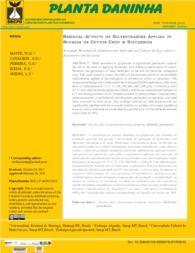Residual activity of Sulfentrazone applied to soybean on cotton crop in succession.
Residual activity of Sulfentrazone applied to soybean on cotton crop in succession.
Author(s): MATTE, W. D.; CAVALIERI, S. D.; PEREIRA, C. S.; IKEDA, F. S.; SHENG, L. Y.
Summary: Weed resistance to glyphosate in agricultural production systems has led to the need of applying herbicides with different mechanisms of action. However, the persistence of these herbicides in the soil can harm the subsequent crop. This study aimed to assess the effect of the residual activity of the herbicide sulfentrazone applied in pre-emergence of soybean on cotton in succession. The experimental design was a randomized block design with five replications, with seven doses of sulfentrazone (0, 37.5, 75, 150, 300, 600, and 1,200 g ha-1). Cotton was sown at 112 days after herbicide application (DAA), with an accumulated precipitation of 637 mm during soybean cycle. Variables related to photosynthetic characteristics, phytointoxication, establishment, development, production components, and yield were assessed in both crops. The residual activity of sulfentrazone did not significantly interfere with the assessed variables in soybean but caused significant losses to cotton, which the recommended dosage (600 g ha-1) of the herbicide reduced cotton yield by 30%.
Publication year: 2019
Types of publication: Journal article
Unit: Embrapa Cotton
Observation
Some of Embrapa's publications are published as ePub files. To read them, use or download one of the following free software options to your computer or mobile device. Android: Google Play Books; IOS: iBooks; Windows and Linux: Calibre.
Access other publications
Access the Agricultural Research Database (BDPA) to consult Embrapa's full library collection and records.
Visit Embrapa Bookstore to purchase books and other publications sold by Embrapa.

